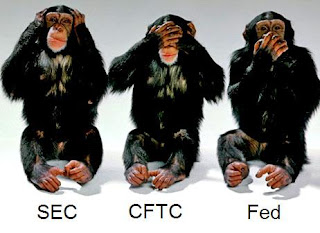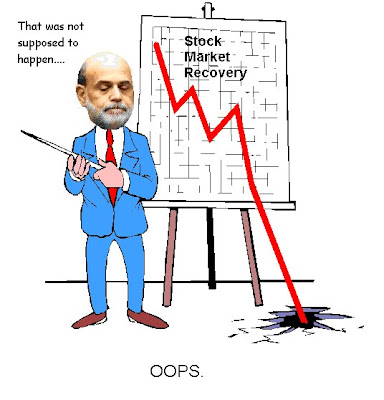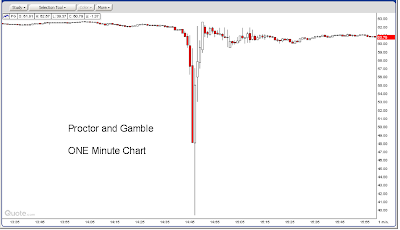PLUNGE! 1987 Style Sudden Drop in US Stocks Driven by Program Trading and a Ponzi Market Structure
Courtesy of JESSE’S CAFÉ AMÉRICAIN
 US equities were gripped by panic selling as the Dow plunged almost 1,000 points driven by a cascade of 100 share high frequency program trading, estimated to have been about 80% of volume. Gold rocketed higher to $1,210.
US equities were gripped by panic selling as the Dow plunged almost 1,000 points driven by a cascade of 100 share high frequency program trading, estimated to have been about 80% of volume. Gold rocketed higher to $1,210.
The stock exchange circuit breakers do not effectively apply after 2:30 PM NY time unless the market declines over 20% and they close the exchange for the day.
A bit of a detail perhaps, but it serves to enhance the convenient artificiality of today’s market break.
This is highly reminiscent of the 1987 crash driven by a flawed market structure based on automated trading and bad theories.
The entire stock market rally which we have seen this year off the February lows resembles a low volume Ponzi scheme, and formed a huge air pocket under prices.
This US equity rally was driven by technically oriented buying from the Banks and the hedge funds. There was and still is a lack of legitimate institutional buying at these price levels. This was machine driven speculation enabled by the lack of reform in a system riddled with corruption, from the bottom to the top.
This is yet another indication that the US regulatory and market oversight organizations, especially the SEC and CFTC, continue to be disconnected from and remarkably ineffective in their responsibilities in guarding the public against gross market abuse, price manipulation, and insiders playing games with cheap money supplied by the NY Fed.
And as you might expect, the anchors on financial television are trying to excuse and blame the sell off on a ‘fat finger’ order that caused Proctor and Gamble to drop 20 points in 45 seconds. Or a typist inputting an order to sell 16 million e-mini SP futures, and typing "B" instead of "M." Oops. Crashed the free world.
"Ordinarily, the financial risk in a market, and hence the risk to the economy at large, is limited because the assets traded are finite. There are only so many houses, mortgages, shares of stock, bushels of corn, [bars of silver], or barrels of oil in which to invest.
But a synthetic instrument has no real assets. It is simply a bet on the performance of the assets it references. That means the number of synthetic instruments is limitless, and so is the risk they present to the economy…
Increasingly, synthetics became bets made by people who had no interest in the referenced assets. Synthetics became the chips in a giant casino, one that created no economic growth even when it thrived, and then helped throttle the economy when the casino collapsed."
US Congressman Carl Levin
Even if any of this was true, it was just the spark that caused the market to plummet because of its highly unstable and artificial technical underpinnings. There is no longer any legitimate price discovery. The US financial system is a casino, dominated by a few big Banks and hedge funds, the gangs of New York.
They’ll never learn. Or is it ‘we?’ They may not really care.
The Market Makers were doing God’s work and maintaining order flow, liquidity, and stability.
The Volatility Index VIX Rocketed
Proctor and Gamble ONE Minute Chart
As noted in previous blogs, I have been long gold and short stocks all week. I took those positions off the table in the plunge.
Now we go into the Non-Farm Payrolls report. This is one broken market, and the plunge was no accident, but the consequence of corruption, neglect, and obscenely ineffective political governance and monetary policy. But we might see a bounce on Friday, and quite a bit of official reassurance over the weekend.
Bear in mind that there is a currency crisis on the horizon, and the IMF will be meeting to discuss it next week.
"Sanity ruled on the Stock Exchange Friday in place of the hysteria of Thursday…In its place was a decidedly improved sentiment; the atmosphere had been cleared and a period of normalcy again reigned.
Sentiment was extremely cautious. While most observers believed the worst of the sharp break was over , they did not look for any immediate recovery…It is the general view that nothing more than backing and filling movements can be expected. Then if conditions are favorable, the groundwork can be laid for a new advance later on."
Wall Street Journal, Saturday, October 26, 1929
The pattern of that market dislocation was for an initial decline on Black Thursday (24th), a recovery on Friday (25th), an uneasy or blue Monday (28th), and then the Great Crash itself on Black Tuesday, October 29, 1929.
But even then, with the market down about 40%, it had a remarkable distance to go. The bottom in US equities was finally reached, down 90% from the September 1929 top, in July of 1932, the trough of the Great Depression.
I am not saying that this will happen again. It turned out very differently in 1987 thanks to a flood of liquidity from the Greenspan Fed. Can Bernanke do the same thing again? One great difference between now and 1929 is that a fiat currency can be devalued, and enormous amounts of liquidity added, with a few phone calls. The Fed is already under pressure to open new dollar swaplines with the ECB. Central banks have the mechanisms of monetizing each others debt, but would generally choose to do so quietly to maintain ‘confidence’ which is their stock in trade.
But it is good to remember that caution is advisable when investing – always, but especially when one decides to exercise their greed reflex.
"Anyone who bought stocks in mid-1929 and held onto them saw most of his or her adult life pass by before getting back to even.”
Richard M. Salsman








